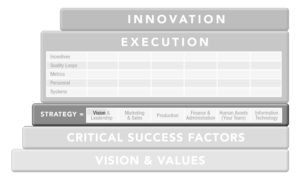This month Intuit, the maker of QuickBooks and Turbo Tax, boldly signaled their vision for Innovation by announcing their purchase of the email marketing company, Mailchimp for $12 billion.
Alex Chriss, Intuit’s executive vice president, said that Intuit will integrate Mailchimp’s marketing, social media and communication tools into QuickBooks, to try to help Intuit’s small business users connect with new customers.
“Our intent is pure acceleration,” Chriss said. “We see this as a massive growth opportunity, and we will continue to invest in Mailchimp.”
This acquisition has implications for Intuit and its customers.
For Intuit itself, it provides a whole new opportunity to provide software and services to organizations, and it signals it wants to chart a course of further integrating innovation into its core products.
With regards to the customers of Intuit, it moves Intuit from being viewed as primarily focused on accounting and tax services, to be a partner that assists businesses obtain new customers, grow revenue, and their expand operations.
All this is being driven by the conclusion that Intuit has come to that to grow to the next level it must have a vision for Innovation that will propel it into new arenas.
But how does this apply to you?
Reconceptualizing Your Business
 The lesson from Intuit is, if you want to take your company to the next level bold actions like this may be necessary.
The lesson from Intuit is, if you want to take your company to the next level bold actions like this may be necessary.
No matter the size of your organization, considering its future and what is required to take your business where you want it to go is a prudent exercise.
Assessing where your company is at and what needs to be done to create the enterprise you desire involves “Reconceptualizing your business”.
Let’s look at how this can be accomplished through our game changing business growth and scaling methodology, the Structure of Success™.
I will cover the process at a high level, but a much more detailed version of it is presented in my 4th book, Work Less, Make More and Have Fun in Your Business, which is due out in September 2022.
There are two components that are necessary to take your business where you want it to go:
- A Vision for what you want your company to look like
- A detailed Strategy of how to get there
Why the Vision For Your Company Is So Important
With regards to developing a Strategy for achieving the goals for your business, the below Structure of Success™ diagram shows why the Vision for your enterprise is so important.
As you can see in the diagram, in the Strategy building block, Vision leads to Marketing & Sales, which then leads to Production, and that in turn leads to the remaining portions of your organization.

This means that everything flows from the Vision you have for your business.
What is a “Vision” for a company?
Vision is the desired or intended future state of a specific organization or enterprise in terms of its fundamental objective and/or strategic direction.
It is where you want to take your business.
It is the direction or destination in which you want your company to go.
It elucidates what a successful and thriving organization looks like to you.
Not a “pie-in-the-sky” Vision, but a concrete, specific, and detailed description of what you want your enterprise to look like.
To develop your company’s initial Vision, you start by conceptualizing what you want to do with your enterprise. This involves dreaming, envisioning, and pondering (possibility thinking)—what your business could look like three, five or even ten years into the future.
For this dreaming process, one year is too short of a time to really get past where your business is at today. I have found that looking three years out is both far enough and near enough to give you the best results.
More than simply wishing or hoping, conceptualizing your Vision is letting your imagination create a clear image of what you want your business to be.
Updating and Revising Your Vision
 How do the Vision for your business and Reconceptualizing it relate to each other?
How do the Vision for your business and Reconceptualizing it relate to each other?
Reconceptualizing involves updating and revising the existing Vision you have for your company.
You want to do this because as your organization matures the question you want to ask yourself is, “Does the Vision for my enterprise need to change in light of what is happening in my marketplace?”
The resetting of your Vision is all about trying to improve your company.
But how do you determine what needs to be done to take your business where you want it to go?
The Process Of Reconceptualizing Your Vision
 Reconceptualizing the Vision for your organization involves the assessment and determination of how you can change your business from its current state to the state you desire it to be in.
Reconceptualizing the Vision for your organization involves the assessment and determination of how you can change your business from its current state to the state you desire it to be in.
To Reconceptualize your enterprise you go through the same process you went through previously of dreaming, envisioning, and pondering (possibility thinking) of what your business could look like three, five or even ten years into the future.
However, now you are completing this process in light of what your company currently looks like, what is occurring in your marketplace, and what you predict will be your customer’s future needs.
I use the term “process” because this is a systematic way of periodically questioning everything regarding your business and being open to reinventing it. Jack Welch, former CEO of General Electric, said, “An organization’s ability to learn and translate that learning into action rapidly is the ultimate competitive advantage.”
Assessing your Vision based on what you see in your marketplace should be done every six months or year.
Keep in mind that your Vision should not change unless you feel that there is a need for your business to change its fundamental direction.
Reconceptualizing Should Produce a Competitive Advantage
 The goal for the process of reconceptualizing your Vision is that you obtain a competitive advantage in the marketplace by staying ahead of your competition!
The goal for the process of reconceptualizing your Vision is that you obtain a competitive advantage in the marketplace by staying ahead of your competition!
As you move through this progression you want to be looking for trends, not fads.
What is the difference?
Trends are movements that are most likely to continue because of huge underlying changes in your market or the world. For instance, things like “green” products, LEED building construction, concern for the environment, energy conservation initiatives, and diversity in the workplace are trends that almost assuredly will continue.
Beanie babies, pet rocks, brown plants, and certain clothing styles were fads and when they disappeared so did their impact on society.
Focus on trends, not fads.
The objective is to compare where your business currently is with what it would look like if it was providing the solution to your customers that will be needed in the future. In this pursuit, be aware there is a state of tension between the current reality of your organization and your desired future solution that will never be fully abated.
The intended outcome from this process is that a compelling, motivating, and captivating plan (i.e., your Vision and Strategy) is developed to move you closer to the desired solution for your customer. The gap between what you want (your Vision for your business) and what your current company looks like should decrease over time.
Where to Start
Start by considering if the Vision for your business needs to change in light of what is happening in your marketplace.
This assessment needs to be focused on providing the solution(s) your customers will desire in the future and should guide you how to develop or acquire the solution(s).
This process involves conceptualizing what you want to do with your business. This action includes dreaming, envisioning, and pondering (possibility thinking)—what your company could look like three, five or even ten years into the future.
Keep in mind as you move through this progression you want to be looking for trends, not fads that will impact your customer and marketplace.
If you could use assistance with Visioning and Reconceptualizing your business, please contact us using the information below so we can be a resource to you in this critical area.
Fountainhead Consulting Group, Inc. is an Innovation and Business Planning firm. During the past 17, years we have shown over 1,200 companies how to achieve their goals by using our unique, comprehensive, and systematic FastTrak Innovation Program™, Innovation Academy™, and Structure of Success™ methodologies. Using the components in these methodologies, each month we examine an aspect of how to transform your business or organization into a true 21st Century enterprise.
Office: (770) 642-4220
www.FountainheadConsultingGroup.com
George.Horrigan@FountainheadConsultingGroup.com
Tags: entrepreneur, front end of innovation, innovation, invention, small business consulting, small business planning, start a business

